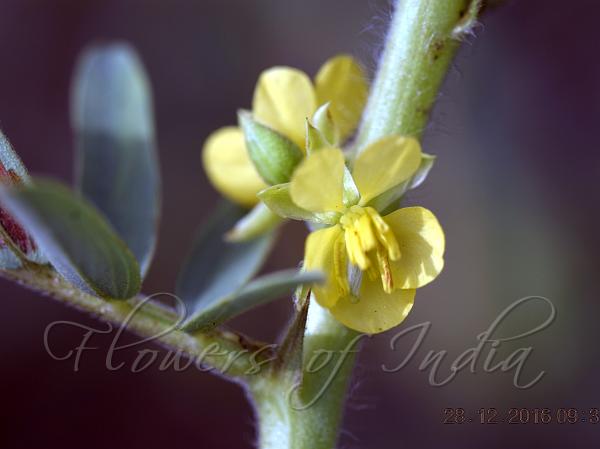|
| Black Grain |
|

|

| File size | 365731 |
| Original date | 12/28/16 9:36 AM |
| Resolution | 2048 x 1536 |
| Flash | Flash did not fire |
| Focal length | 90.0mm |
| Exposure time | 1/400s |
| Aperture | 7.1 |
| Focus Distance | |
| Metering Mode | Multi-segment |
| Camera make | NIKON CORPORATION |
| Camera model | NIKON D3300 |
| Sensor type | OneChipColorArea |
|
|
|
|
Photo: |
Botanical name: Chamaecrista nigricans Family: Caesalpiniaceae (Gulmohar family)
Synonyms: Cassia nigricans
Synonyms: Cassia nigricans
Black Grain is an annual herb, upto 75 cm tall,
velvet-hairy with short crisped and long spreading hairs. Leaves are
alternate, distichous in two planes across the plane of branching;
leaf-axis (including leaf-stalk) 5-9 cm long, velvet-hairy; leaflets
7-18 pairs, 1-2.5 x 0.3-0.6 cm, narrowly oblong or linear-oblong, blunt
or rounded at tip, with a short sharp point, oblique at base,
velvet-hairy; gland solitary, stalkless, 2-4 mm long, cushion-shaped,
covering half to one-third upper part of leaf-stalk; stipules 4-6 mm
long, linear-lanceshaped, tapering, velvet-hairy. Flowers are borne 2-5
together, supra-in leaf-axils; flower-stalks 1-3 mm long, velvet-hairy;
bracts and bracteoles linear, pointed, velvet-hairy. Sepals 4-5 mm
long, pointed, velvet-hairy outside. Petals are yellow or yellowish
red, equalling the sepals. Stamens are 10, all fertile or rarely 3
reduced to staminodes; anthers of 3 different sizes, linear, splitting
apically. Pods are 2-3 x 0.5 cm, erect, linear-oblong, flat, straight,
velvet-hairy, 2-valved, 4 to 10-seeded, black to brown when ripe;
valves coiling on splitting; seeds 2.5-3.5 x 1.5-2.5 mm, nearly round,
obovate; areole absent; albumen thin. Black Grain is found in West
Asia, Tropical Africa, India and Sri Lanka.
Medicinal uses: In Africa, an infusion of the
leaves or aerial parts is taken against fever and malaria, and to treat
stomach-ache, diarrhoea and worms. Externally, an infusion or decoction
of the leaves is applied to wounds and abscesses as an antiseptic. The
root is pounded with water and taken against diarrhoea, while in
decoction it is taken as an anthelmintic. A decoction of the leaves is
also taken as cough medicine, and is externally applied for itching.
The pounded leaves in water are applied to ticks on humans and horses,
while pounded leaves in palm oil are rubbed on the head to kill lice.
In Africa, an infusion of the
leaves or aerial parts is taken against fever and malaria, and to treat
stomach-ache, diarrhoea and worms. Externally, an infusion or decoction
of the leaves is applied to wounds and abscesses as an antiseptic. The
root is pounded with water and taken against diarrhoea, while in
decoction it is taken as an anthelmintic. A decoction of the leaves is
also taken as cough medicine, and is externally applied for itching.
The pounded leaves in water are applied to ticks on humans and horses,
while pounded leaves in palm oil are rubbed on the head to kill lice.
Medicinal uses:
 In Africa, an infusion of the
leaves or aerial parts is taken against fever and malaria, and to treat
stomach-ache, diarrhoea and worms. Externally, an infusion or decoction
of the leaves is applied to wounds and abscesses as an antiseptic. The
root is pounded with water and taken against diarrhoea, while in
decoction it is taken as an anthelmintic. A decoction of the leaves is
also taken as cough medicine, and is externally applied for itching.
The pounded leaves in water are applied to ticks on humans and horses,
while pounded leaves in palm oil are rubbed on the head to kill lice.
In Africa, an infusion of the
leaves or aerial parts is taken against fever and malaria, and to treat
stomach-ache, diarrhoea and worms. Externally, an infusion or decoction
of the leaves is applied to wounds and abscesses as an antiseptic. The
root is pounded with water and taken against diarrhoea, while in
decoction it is taken as an anthelmintic. A decoction of the leaves is
also taken as cough medicine, and is externally applied for itching.
The pounded leaves in water are applied to ticks on humans and horses,
while pounded leaves in palm oil are rubbed on the head to kill lice.
| Identification credit: S. Kasim | Photographed in Radhapuram, Tirunelveli Dist, Tamil Nadu. |
• Is this flower misidentified? If yes,